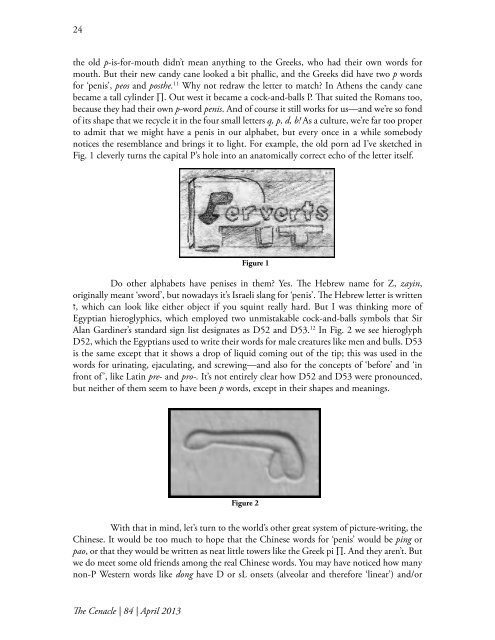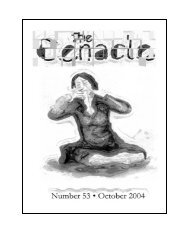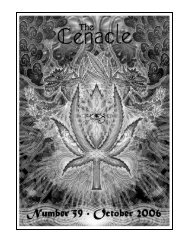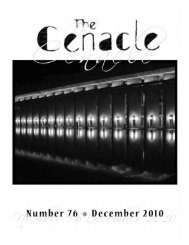Joe Ciccone - The ElectroLounge
Joe Ciccone - The ElectroLounge
Joe Ciccone - The ElectroLounge
Create successful ePaper yourself
Turn your PDF publications into a flip-book with our unique Google optimized e-Paper software.
24<br />
the old p-is-for-mouth didn’t mean anything to the Greeks, who had their own words for<br />
mouth. But their new candy cane looked a bit phallic, and the Greeks did have two p words<br />
for ‘penis’, peos and posthe. 11 Why not redraw the letter to match In Athens the candy cane<br />
became a tall cylinder ∏. Out west it became a cock-and-balls P. That suited the Romans too,<br />
because they had their own p-word penis. And of course it still works for us—and we’re so fond<br />
of its shape that we recycle it in the four small letters q, p, d, b! As a culture, we’re far too proper<br />
to admit that we might have a penis in our alphabet, but every once in a while somebody<br />
notices the resemblance and brings it to light. For example, the old porn ad I’ve sketched in<br />
Fig. 1 cleverly turns the capital P’s hole into an anatomically correct echo of the letter itself.<br />
Figure 1<br />
Do other alphabets have penises in them Yes. <strong>The</strong> Hebrew name for Z, zayin,<br />
originally meant ‘sword’, but nowadays it’s Israeli slang for ‘penis’. <strong>The</strong> Hebrew letter is written<br />
which can look like either object if you squint really hard. But I was thinking more of ,ז<br />
Egyptian hieroglyphics, which employed two unmistakable cock-and-balls symbols that Sir<br />
Alan Gardiner’s standard sign list designates as D52 and D53. 12 In Fig. 2 we see hieroglyph<br />
D52, which the Egyptians used to write their words for male creatures like men and bulls. D53<br />
is the same except that it shows a drop of liquid coming out of the tip; this was used in the<br />
words for urinating, ejaculating, and screwing—and also for the concepts of ‘before’ and ‘in<br />
front of’, like Latin pre‐ and pro-. It’s not entirely clear how D52 and D53 were pronounced,<br />
but neither of them seem to have been p words, except in their shapes and meanings.<br />
Figure 2<br />
With that in mind, let’s turn to the world’s other great system of picture-writing, the<br />
Chinese. It would be too much to hope that the Chinese words for ‘penis’ would be ping or<br />
pao, or that they would be written as neat little towers like the Greek pi ∏. And they aren’t. But<br />
we do meet some old friends among the real Chinese words. You may have noticed how many<br />
non-P Western words like dong have D or sL onsets (alveolar and therefore ‘linear’) and/or<br />
<strong>The</strong> Cenacle | 84 | April 2013









